On the Hydrodynamic Geometry of Flow-Through versus Restricted Lagoons
Abstract
:1. Introduction
2. Materials and Methods
2.1. Description of the Study Areas
2.2. The Hydrodynamic Code and the Advection–Diffusion Code
2.3. Computational Domain and Grid
2.3.1. The Nidova Lagoon
2.3.2. The Papas Lagoon
2.4. Boundary and Initial Conditions
2.5. The Tracer
3. Results and Discussion
3.1. Hydrodynamic Characteristics of the Lagoon Ecosystems
3.2. Residence Time of the Lagoons
3.2.1. The Nidova Lagoon
3.2.2. The Papas Lagoon
4. Conclusions
Acknowledgments
Author Contributions
Conflicts of Interest
References
- Colombo, G. Lagoons. In The Coastline; Barnes, R.S.K., Ed.; John Wiley and Sons: New York, NY, USA, 1977; pp. 63–81. [Google Scholar]
- Tsihrintzis, V.A.; Sylaios, G.K.; Sidiropoulou, M.; Koutrakis, E.T. Hydrodynamic modeling and management alternatives in a Mediterranean, fishery exploited, coastal lagoon. Aquac. Eng. 2007, 36, 310–324. [Google Scholar] [CrossRef]
- Koutsikopoulos, C.; Dimitriou, E.; Rogdakis, Y.; Katselis, G.; Pagoni, S.; Kentrou, A.; Koutrakis, E.; Cladas, Y.; Economidis, P.S. A typology of the Hellenic lagoons based on physical and socio–economic aspects on their fisheries characteristics. In Proceedings of the International Conference on Lagoons and Coastal Wetlands in the Global Change Context, Impacts and Management Issues, Venice, Italy, 26–28 April 2004; pp. 26–28. [Google Scholar]
- Cataudella, S.; Crosetti, D.; Massa, F. Mediterranean Coastal Lagoons: Sustainable Management and Interactions among Aquaculture, Capture Fisheries and the Environment; Food and Agriculture Organization of the United Nations (FAO) Studies and Reviews No. 95; FAO: Rome, Italy, 2015; p. 278. [Google Scholar]
- Dimitriou, E.; Economidis, P.S.; Athanasopoulos, T.; Kapareliotis, A.; Katselis, G.; Koutrakis, E.; Koutsikopoulos, K.; Liourdi, M.; Manios, V.; Roussi, A.; et al. Study of the organization and function of fishery use in lagoons. PESCA, ICHTHIKA S.A., Department of Fish-farming and Inland Waters, Hellenic Ministry of Agriculture, 2001; Unpublished work. [Google Scholar]
- Corsi, F.; Ardizzone, G.D. Some environmental conditions affecting yellow eels catchability. Oebalia 1985, 11, 561–571. [Google Scholar]
- Chauvet, C. Manuel Sur I Amenagement Des Peches Dans Les Lagunes Cotieres La Bordigue Mediterraneenne Fao Document Technique Sur Les Peches 290; Food and Agriculture Organization of the United Nations (FAO): Rome, Italy, 1988; p. 77. [Google Scholar]
- Armenio, E.; De Serio, F.; Mossa, M. Analysis of data characterizing tide and current fluxes in coastal basins. Hydrol. Earth Syst. Sci. 2017, 21, 3441–3454. [Google Scholar] [CrossRef]
- De Serio, F.; Mossa, M. Meteo and hydrodynamic measurements to detect physical processes in confined shallow seas. Sensors 2018, 18, 280. [Google Scholar] [CrossRef] [PubMed]
- Kjerfve, B. Comparative oceanography of coastal lagoons. In Estuarine Variability; Kennedy, V.S., Ed.; Academic Press: New York, NY, USA, 1986; pp. 63–81. [Google Scholar]
- Andréfouët, S.; Pagés, J.; Tartinville, B. Water renewal time for classification of atoll lagoons in the Tuamotu Archipelago (French Polynesia). Coral Reef. 2001, 20, 399–408. [Google Scholar] [CrossRef]
- Aubrey, D.G.; Giese, G.S. Formation and Evolution of Multiple Tidal Inlets; American Geophysical Union: Washington, DC, USA, 1993. [Google Scholar]
- Papatheodorou, G.; Avramidis, P.; Fakiris, E.; Christodoulou, D.; Kontopoulos, N. Bed diversity in the shallow water environment of Pappas Lagoon in Greece. Int. J. Sediment Res. 2012, 27, 1–17. [Google Scholar] [CrossRef]
- Krasakopoulou, E.; Pagou, K. Seasonal steady-state budgets of nutrients and stoichiometric calculations in an Eastern Mediterranean lagoon (Papas Lagoon-Greece). Mediterr. Mar. Sci. 2011, 12, 21–41. [Google Scholar] [CrossRef]
- DHI. MIKE C-MAP, Extraction of World Wide Bathymetry Data and Tidal Information. DHI Software, Version 2014. Available online: https://www.mikepoweredbydhi.com/download/mike-by-dhi-2014 (accessed on 15 January 2018).
- Google Earth Pro, Version 7.3.0.3832. Available online: http://www.google.com/earth/download/ge/agree.html (accessed on 17 January 2018).
- National Centre for Marine Research (NCMR). Monitoring of the Papas Lagoon (Cape Araxos/Achaia) Ecosystem—Management and Protection Proposal; Final Technical Report; Pagou, K., Ed.; NCMR: Athens, Greece, 2000; p. 190. [Google Scholar]
- Cladas, Y.; Papantoniou, G.; Bekiari, V.; Fragkopoulu, N. Dystrophic crisis event in Papas Lagoon, Araxos Cape, Western Greece in the summer 2012. Mediterr. Mar. Sci. 2016, 17, 32–38. [Google Scholar] [CrossRef]
- DHI. MIKE 3 FLOW MODEL FM. Hydrodynamic Module—User Guide. DHI Software. p. 138. Available online: https://www.mikepoweredbydhi.com/download/mike-by-dhi-2014 (accessed on 15 January 2018).
- DHI. MIKE 21 FLOW MODEL FM. Hydrodynamic Module—User Guide. DHI Software. p. 132. Available online: https://www.mikepoweredbydhi.com/download/mike-by-dhi-2014 (accessed on 15 January 2018).
- Fourniotis, N.T.; Horsch, G.M. Baroclinic circulation in the Gulf of Patras (Greece). Ocean Eng. 2015, 104, 238–248. [Google Scholar] [CrossRef]
- DHI. MIKE 3 FLOW MODEL FM. Transport Module—User Guide. DHI Software. p. 46. Available online: https://www.mikepoweredbydhi.com/download/mike-by-dhi-2014 (accessed on 15 January 2018).
- Achilleopoulos, P. Tides in Gulfs and Straits of Western Greece. Ph.D. Thesis, University of Patras, Patras, Greece, 1990. [Google Scholar]
- Horsch, G.M.; Fourniotis, N.T. Wintertime Tidal Hydrodynamics in the Gulf of Patras, Greece. J. Coastal Res. 2017, 33, 1305–1314. [Google Scholar] [CrossRef]
- Avramidis, P.; Bekiari, V.; Christodoulou, D.; Papatheodorou, G. Sedimentology and water column stratification in a permanent anoxic Mediterranean lagoon environment, Aetoliko lagoon, western Greece. Environ. Earth Sci. 2015, 73, 5687–5701. [Google Scholar] [CrossRef]
- Marazioti, C.; Flessia, G.; Vlachos, P.; Koutrouli, E.; Ntaikou, I.; Antonopoulou, G.; Pakou, C.; Kalfas, K.; Kornaros, M.; Lyberatos, G. On the environmental State of the Mesologgi Lagoon in Greece. Fresen. Environ. Bull. 2010, 19, 1151–1164. [Google Scholar]
- Papailiou, D.D. Oceanographical Study in Patras Gulf Waters for Pollution Management; University of Patras, Department of Mechanical Engineering: Patras, Greece, 1982; Volume 2, p. 161. (In Greek) [Google Scholar]
- Cladas, Y.; Papantoniou, G.; Ketsilis, V.; Fragopoulou, N. Dystrophic crisis event Papas Lagoon (Araxos Achaia). In Proceedings of the 15th Panhellenic Ichthyologists’ Conference, Acquatic Ecosystems: Uses, Impact and Management, Thessaloniki, Greece, 2013; pp. 10–13. [Google Scholar]
- Monsen, N.; Cloern, J.; Lucas, L.; Monismith, S. A comment on the use of flushing time, residence time and age as transport time scales. Limnol. Oceanogr. 2002, 47, 1545–1553. [Google Scholar] [CrossRef]
- Stamou, A.I.; Loverdou, L.; Matsoukis, C.; Albanis, T.; Gkesouli, A. Modeling renewal times in Amvrakikos gulf, Greece. Global NEST J. 2012, 14, 386–392. [Google Scholar]
- Ranjbar, M.H.; Zaker, H.N. Numerical modeling of general circulation, thermohaline structure, and residence time in Gorgan Bay, Iran. Ocean Dyn. 2018, 68, 35–46. [Google Scholar] [CrossRef]
- Eginitis, D. The problem of the tide of Euripus. Astron. Nachr. 1929, 236, 321–328. [Google Scholar] [CrossRef]
- Tsimplis, M.N. Tides and sea-level variability at the Strait of Euripus. Estuar. Coast. Shelf Sci. 1997, 44, 91–101. [Google Scholar] [CrossRef]
- Eginitis, D. The problem of the tide of Euripus. Pragmatiai Acad. Athens 1929, A, 127. [Google Scholar]
- Gill, A.E. Atmosphere-Ocean Dynamics; Academic Press: San Diego, CA, USA, 1982; p. 662. [Google Scholar]
- Li, Y.; Wolanski, E.; Zhang, H. What processes control the net currents through shallow straits? A review with application to the Bohai strait, China. Estuar. Coast. Shelf Sci. 2015, 158, 1–11. [Google Scholar] [CrossRef]
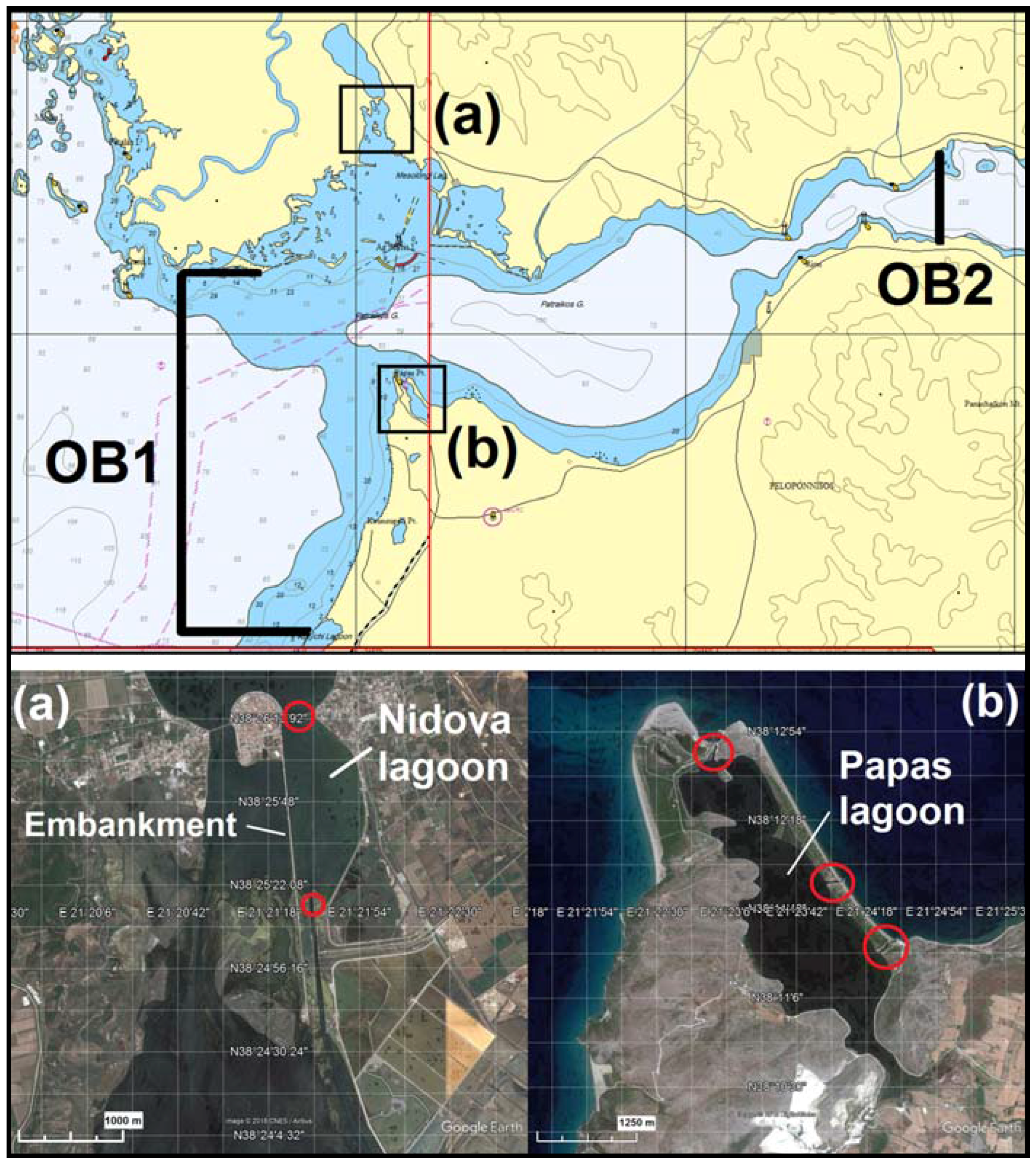
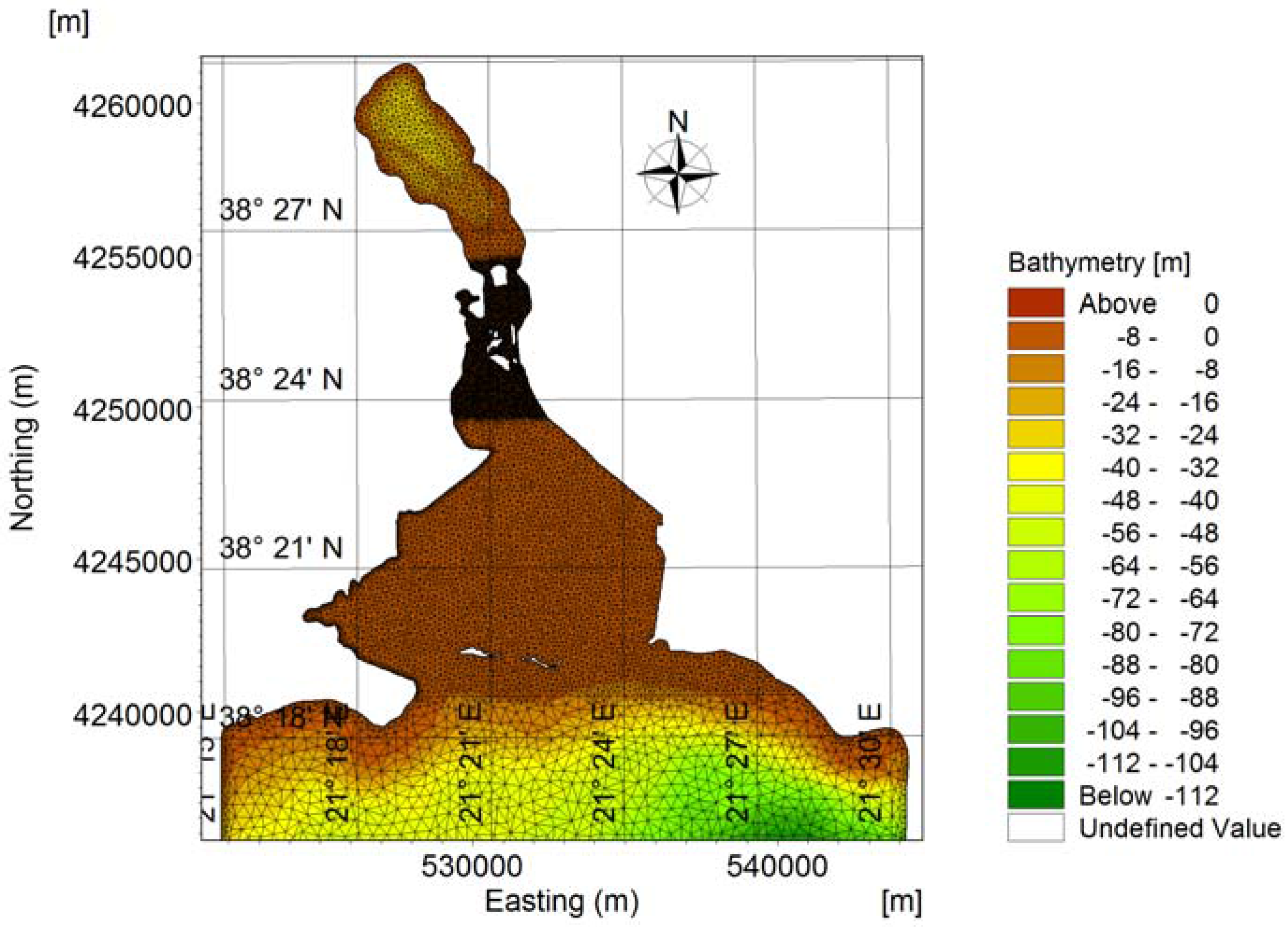
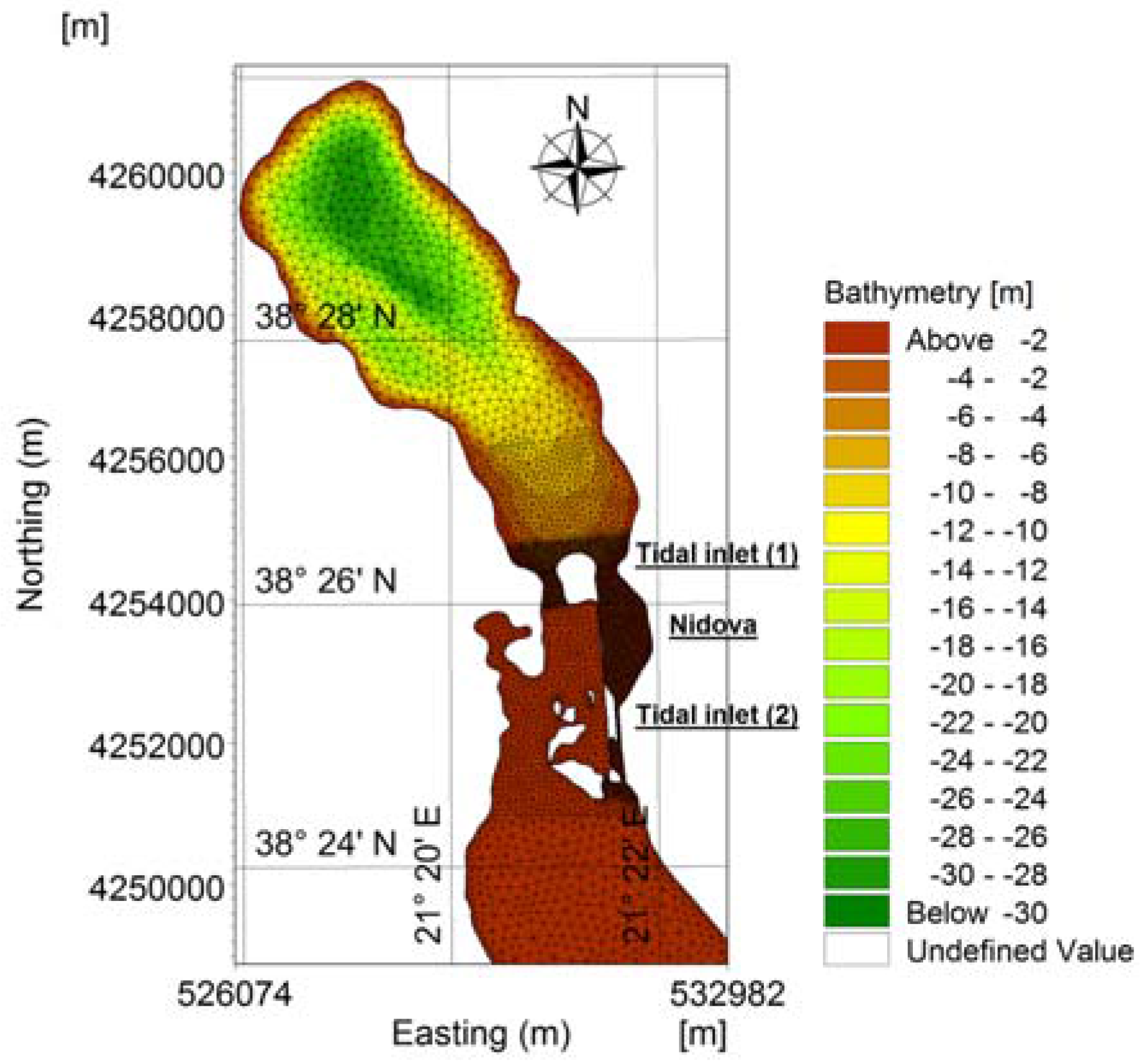
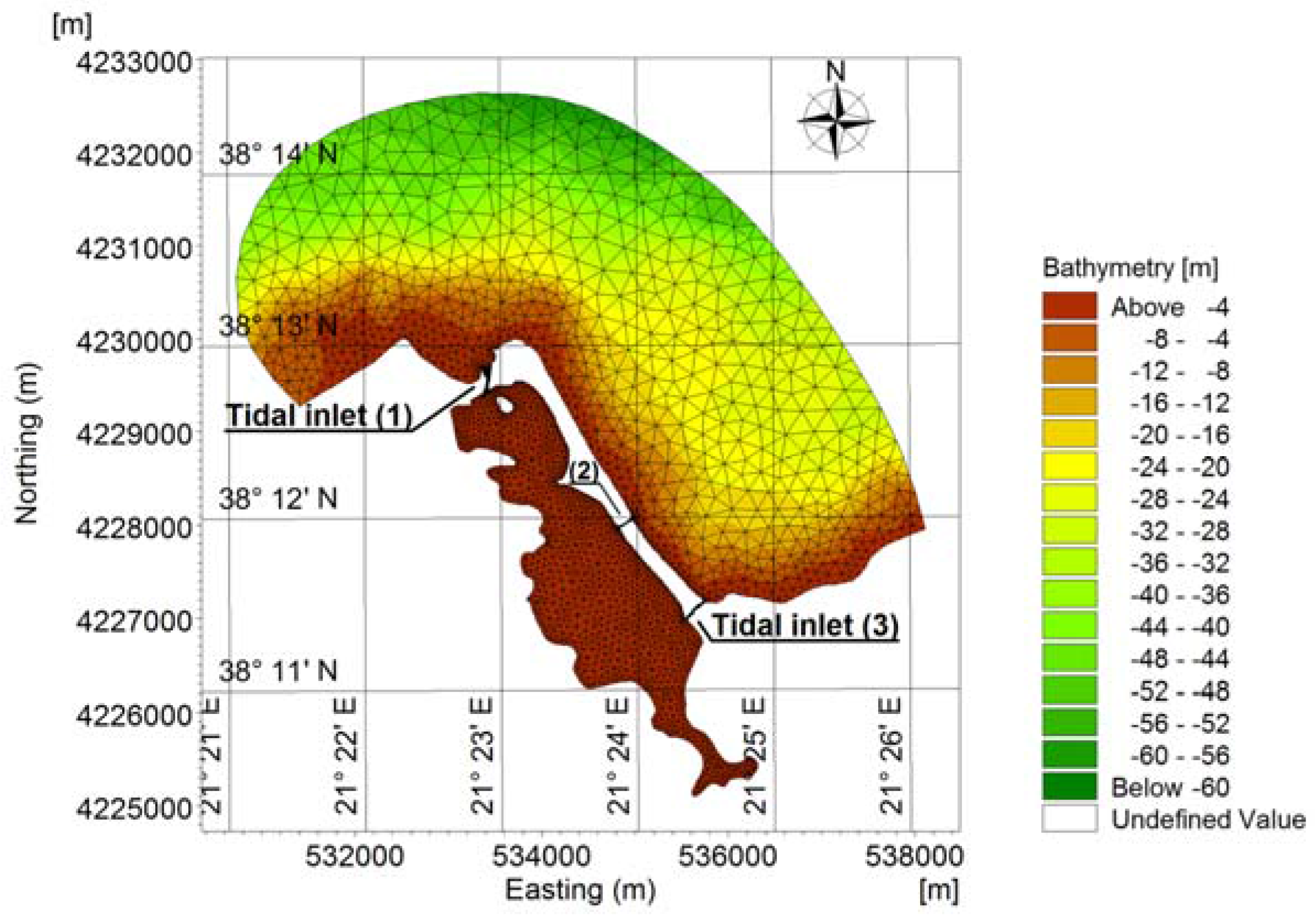
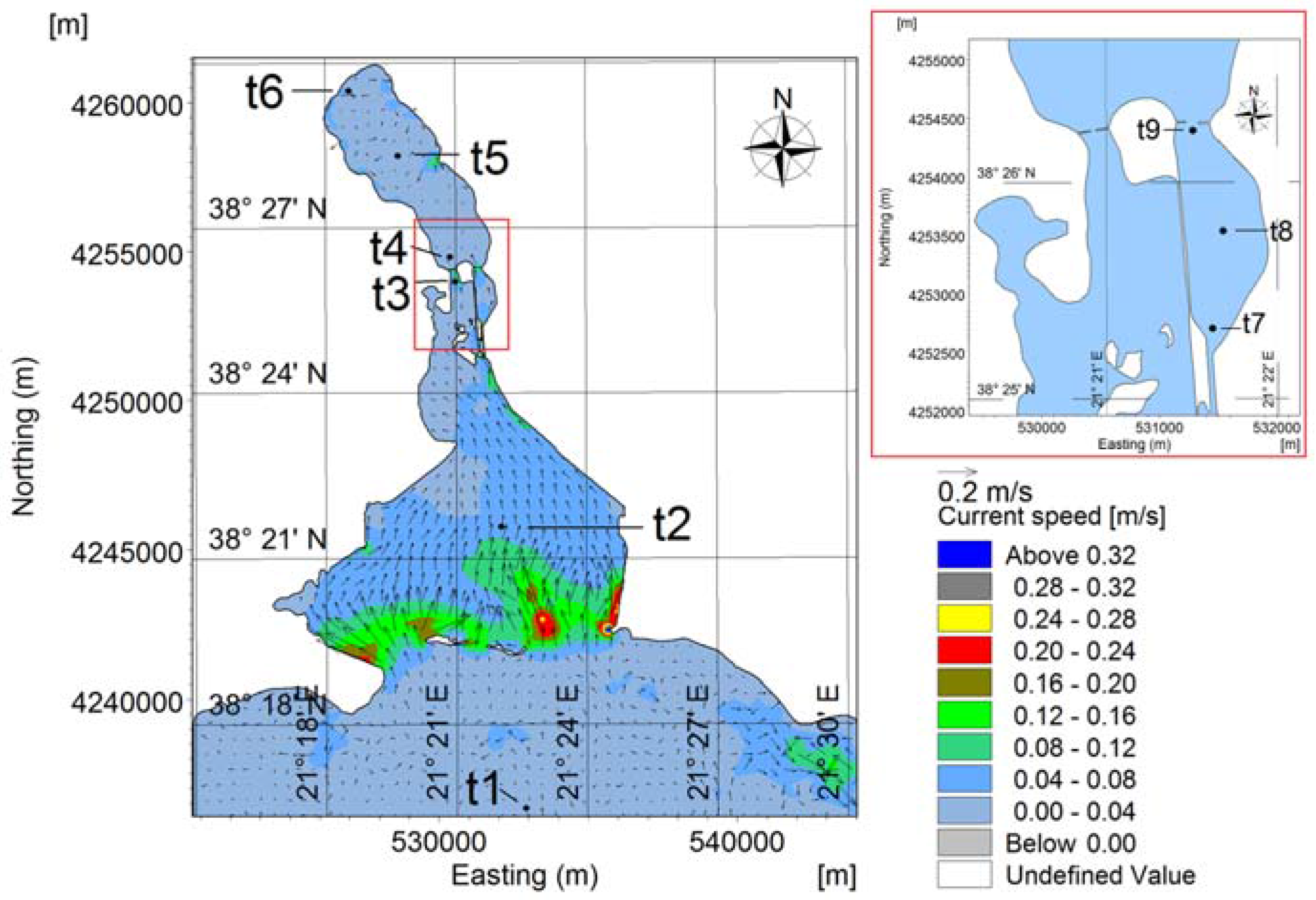



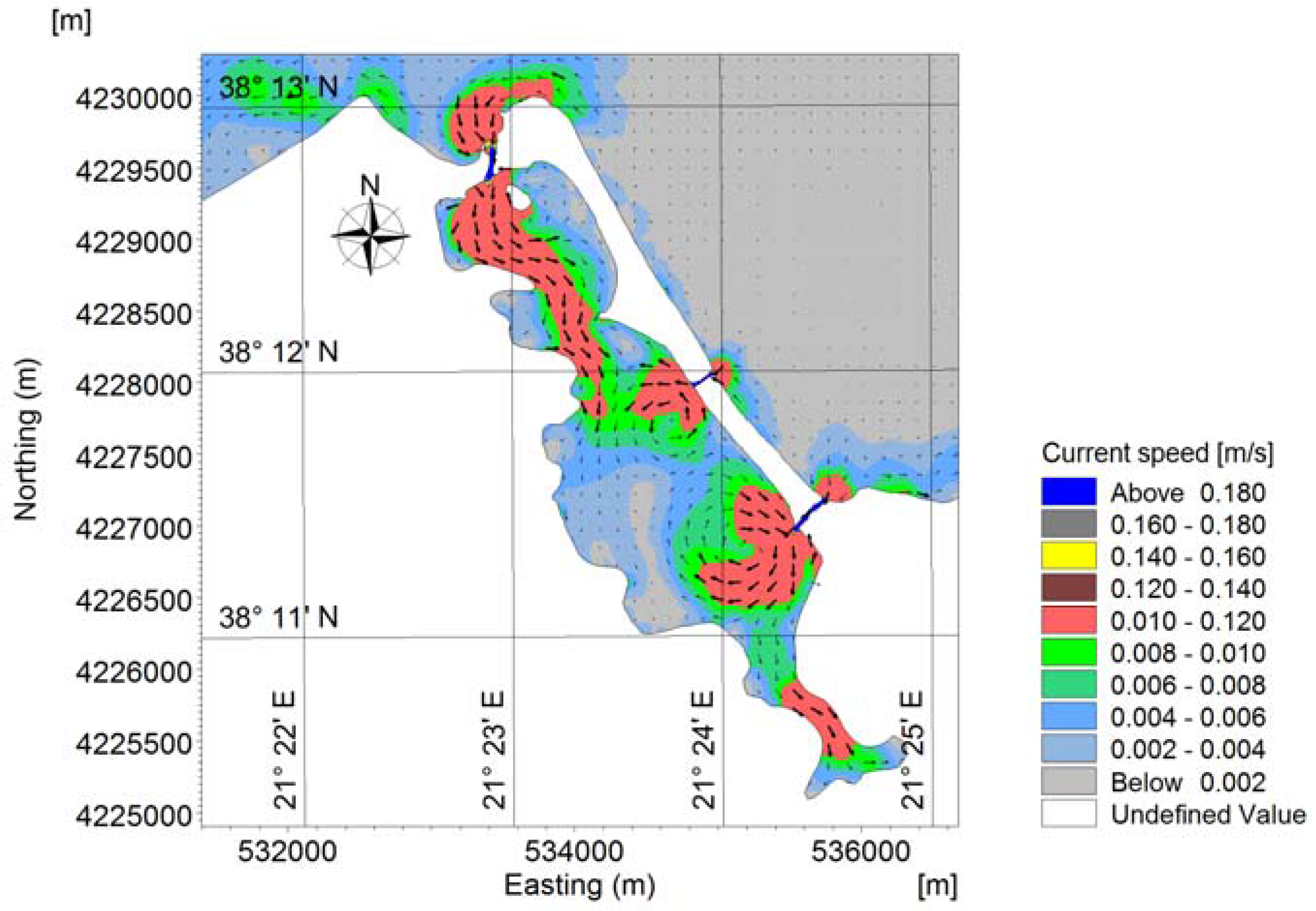
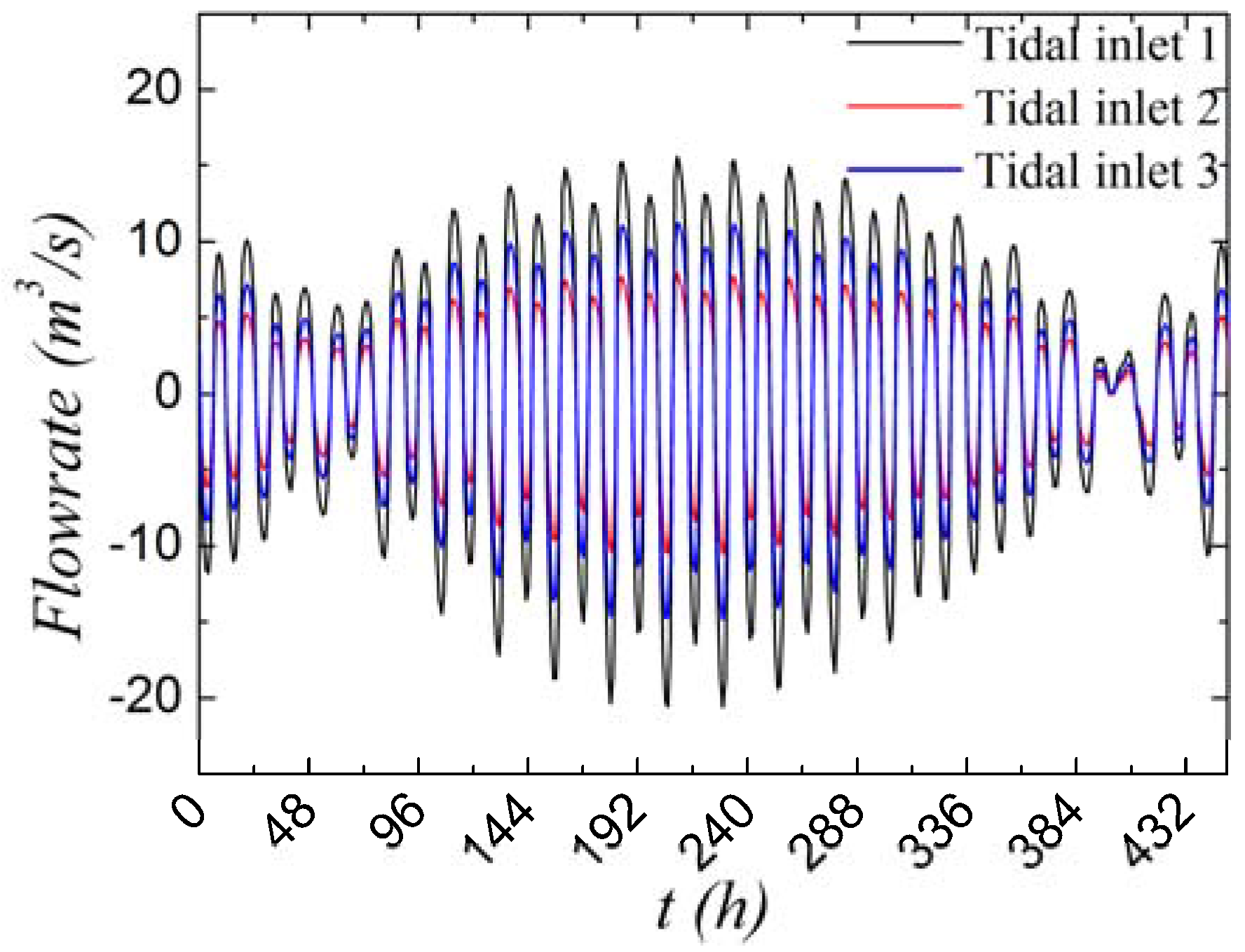
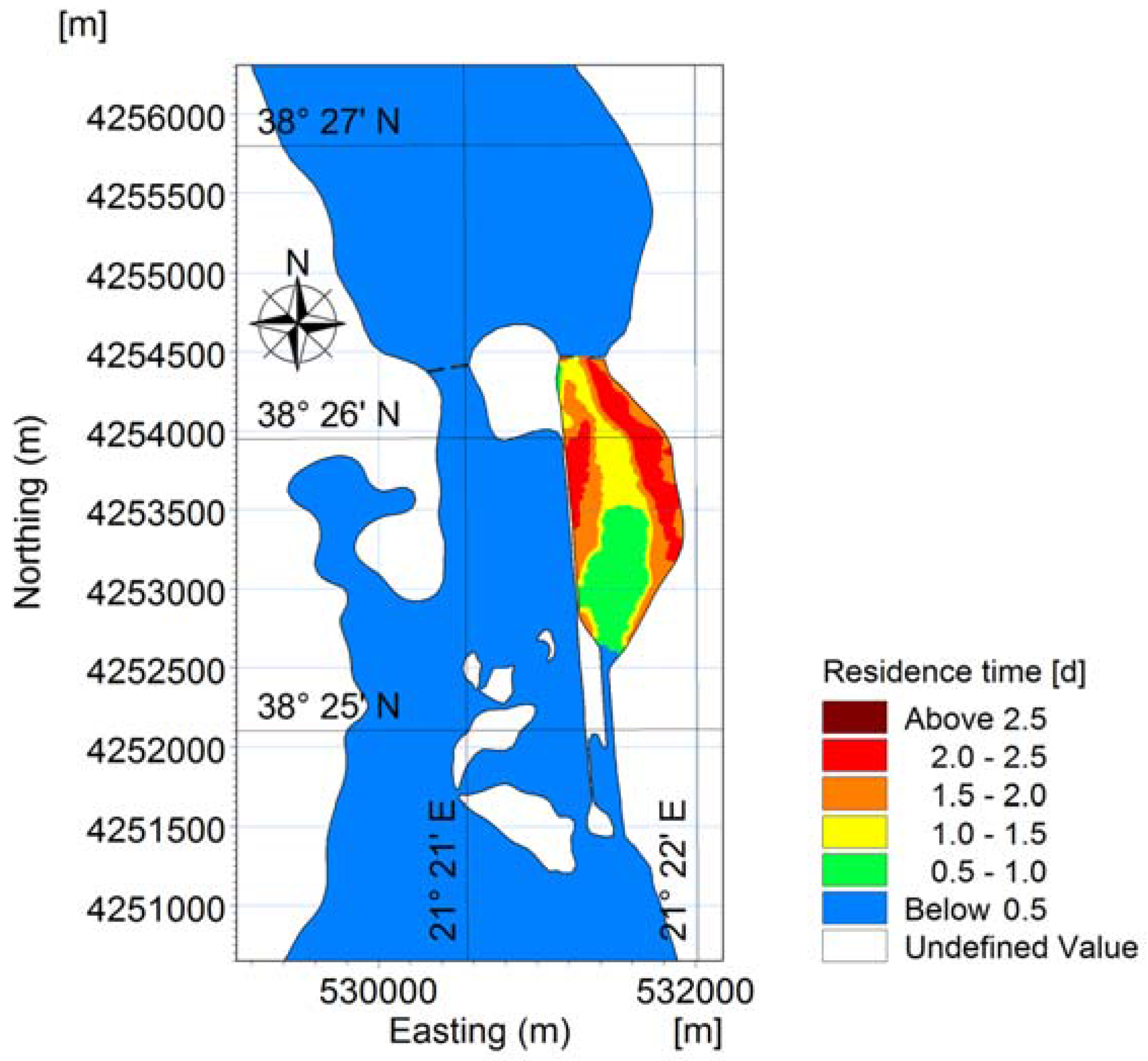
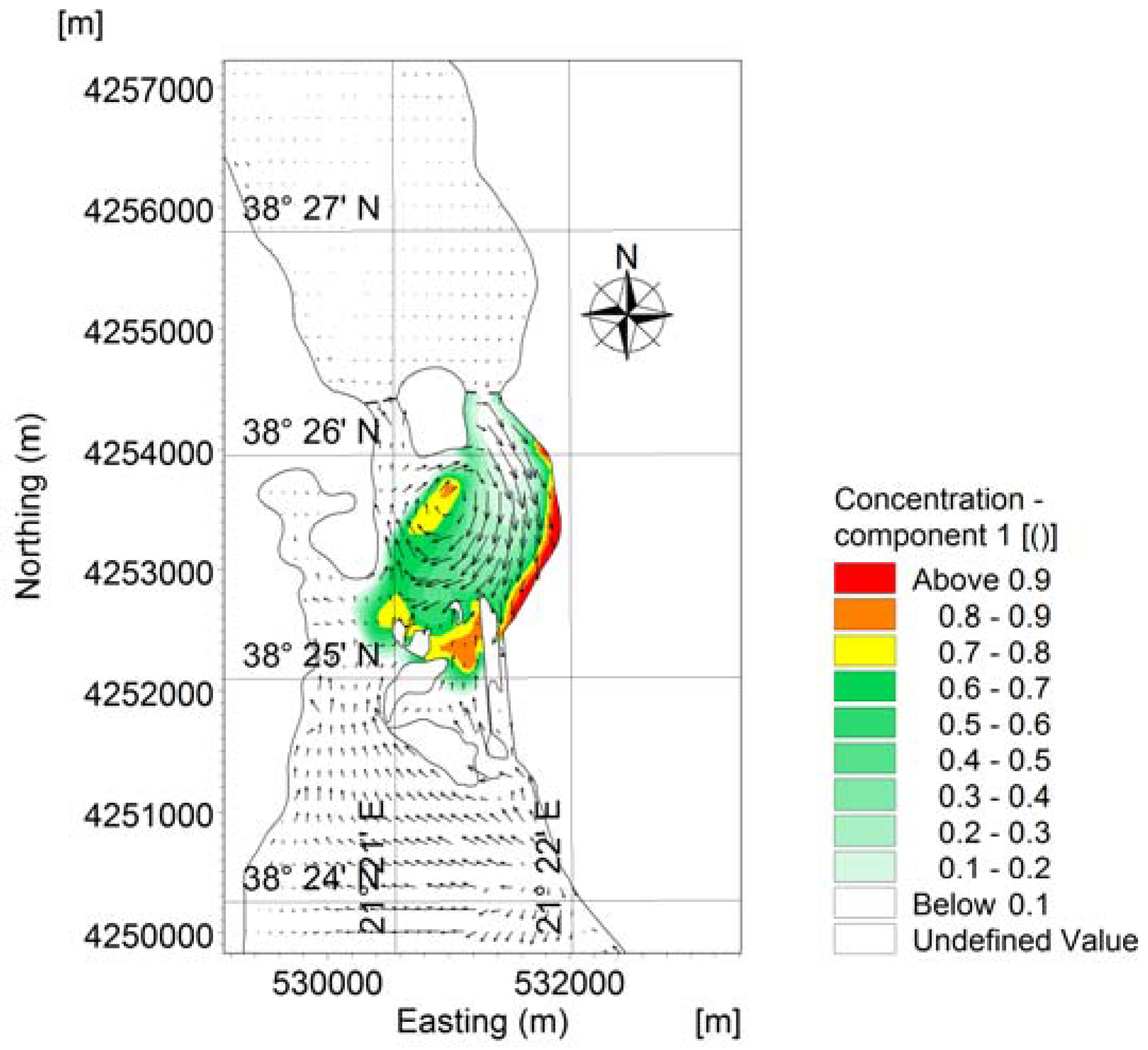
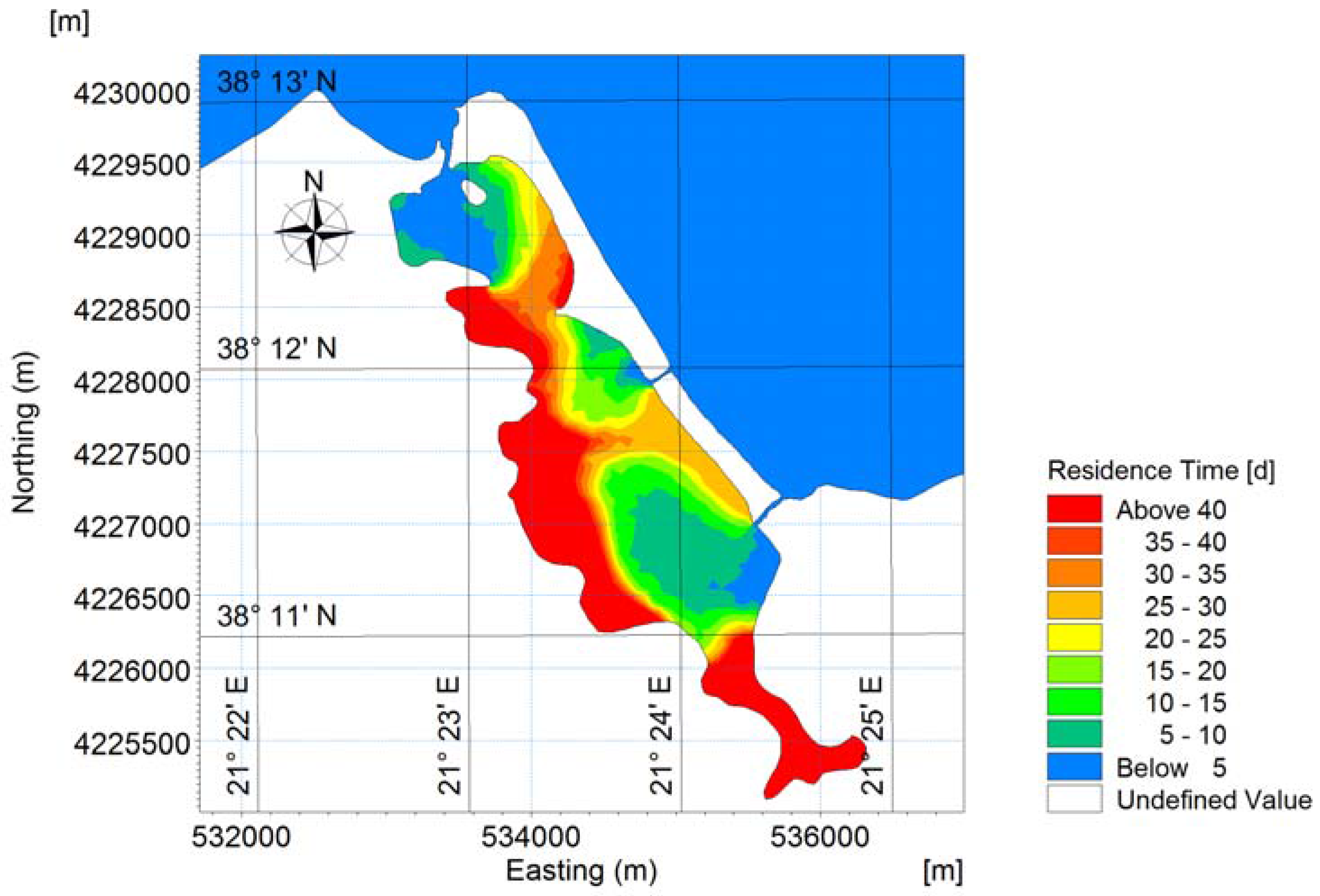
© 2018 by the authors. Licensee MDPI, Basel, Switzerland. This article is an open access article distributed under the terms and conditions of the Creative Commons Attribution (CC BY) license (http://creativecommons.org/licenses/by/4.0/).
Share and Cite
Fourniotis, N.T.; Horsch, G.M.; Leftheriotis, G.A. On the Hydrodynamic Geometry of Flow-Through versus Restricted Lagoons. Water 2018, 10, 237. https://doi.org/10.3390/w10030237
Fourniotis NT, Horsch GM, Leftheriotis GA. On the Hydrodynamic Geometry of Flow-Through versus Restricted Lagoons. Water. 2018; 10(3):237. https://doi.org/10.3390/w10030237
Chicago/Turabian StyleFourniotis, Nikolaos Th., Georgios M. Horsch, and Georgios A. Leftheriotis. 2018. "On the Hydrodynamic Geometry of Flow-Through versus Restricted Lagoons" Water 10, no. 3: 237. https://doi.org/10.3390/w10030237




